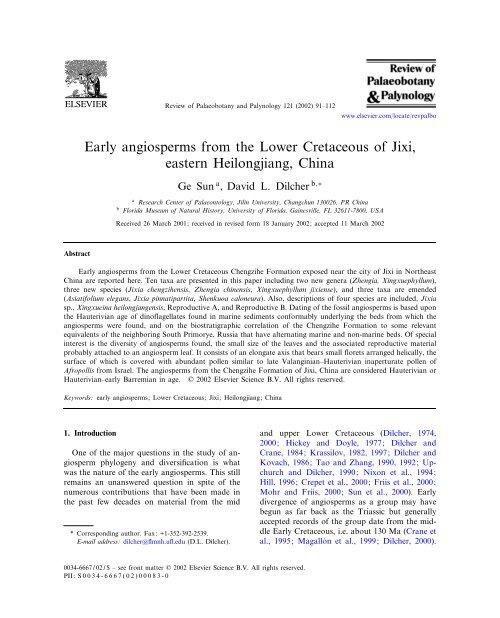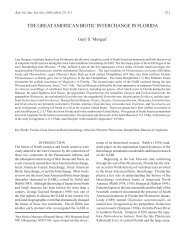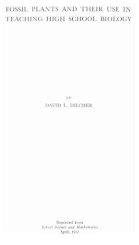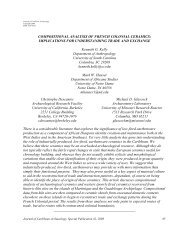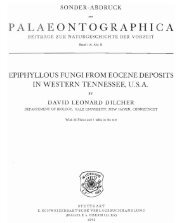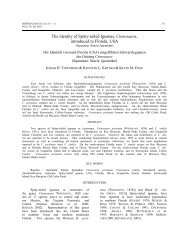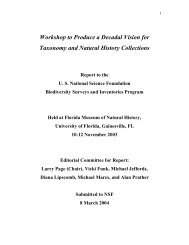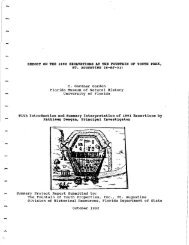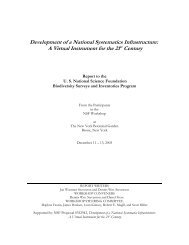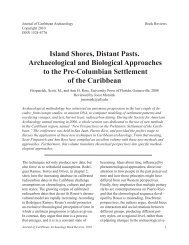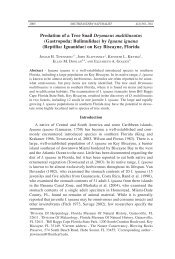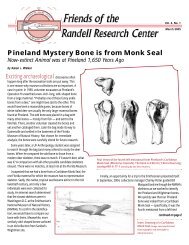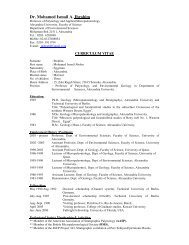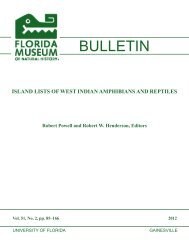Early angiosperms from the Lower Cretaceous of Jixi, eastern ...
Early angiosperms from the Lower Cretaceous of Jixi, eastern ...
Early angiosperms from the Lower Cretaceous of Jixi, eastern ...
You also want an ePaper? Increase the reach of your titles
YUMPU automatically turns print PDFs into web optimized ePapers that Google loves.
Abstract<br />
<strong>Early</strong> <strong>angiosperms</strong> <strong>from</strong> <strong>the</strong> <strong>Lower</strong> <strong>Cretaceous</strong> <strong>of</strong> <strong>Jixi</strong>,<br />
<strong>eastern</strong> Heilongjiang, China<br />
Ge Sun a , David L.Dilcher b;<br />
a Research Center <strong>of</strong> Palaeontology, Jilin University, Changchun 130026, PR China<br />
b Florida Museum <strong>of</strong> Natural History, University <strong>of</strong> Florida, Gainesville, FL 32611-7800, USA<br />
Received 26 March 2001; received in revised form 18 January 2002; accepted 11 March 2002<br />
<strong>Early</strong> <strong>angiosperms</strong> <strong>from</strong> <strong>the</strong> <strong>Lower</strong> <strong>Cretaceous</strong> Chengzihe Formation exposed near <strong>the</strong> city <strong>of</strong> <strong>Jixi</strong> in Nor<strong>the</strong>ast<br />
China are reported here.Ten taxa are presented in this paper including two new genera (Zhengia, Xingxuephyllum),<br />
three new species (<strong>Jixi</strong>a chengzihensis, Zhengia chinensis, Xingxuephyllum jixiense), and three taxa are emended<br />
(Asiatifolium elegans, <strong>Jixi</strong>a pinnatipartita, Shenkuoa caloneura).Also, descriptions <strong>of</strong> four species are included, <strong>Jixi</strong>a<br />
sp., Xingxueina heilongjangensis, Reproductive A, and Reproductive B.Dating <strong>of</strong> <strong>the</strong> fossil <strong>angiosperms</strong> is based upon<br />
<strong>the</strong> Hauterivian age <strong>of</strong> din<strong>of</strong>lagellates found in marine sediments conformably underlying <strong>the</strong> beds <strong>from</strong> which <strong>the</strong><br />
<strong>angiosperms</strong> were found, and on <strong>the</strong> biostratigraphic correlation <strong>of</strong> <strong>the</strong> Chengzihe Formation to some relevant<br />
equivalents <strong>of</strong> <strong>the</strong> neighboring South Primorye, Russia that have alternating marine and non-marine beds.Of special<br />
interest is <strong>the</strong> diversity <strong>of</strong> <strong>angiosperms</strong> found, <strong>the</strong> small size <strong>of</strong> <strong>the</strong> leaves and <strong>the</strong> associated reproductive material<br />
probably attached to an angiosperm leaf.It consists <strong>of</strong> an elongate axis that bears small florets arranged helically, <strong>the</strong><br />
surface <strong>of</strong> which is covered with abundant pollen similar to late Valanginian^Hauterivian inaperturate pollen <strong>of</strong><br />
Afropollis <strong>from</strong> Israel.The <strong>angiosperms</strong> <strong>from</strong> <strong>the</strong> Chengzihe Formation <strong>of</strong> <strong>Jixi</strong>, China are considered Hauterivian or<br />
Hauterivian^early Barremian in age.ß 2002 Elsevier Science B.V.All rights reserved.<br />
Keywords: early <strong>angiosperms</strong>; <strong>Lower</strong> <strong>Cretaceous</strong>; <strong>Jixi</strong>; Heilongjiang; China<br />
1. Introduction<br />
One <strong>of</strong> <strong>the</strong> major questions in <strong>the</strong> study <strong>of</strong> angiosperm<br />
phylogeny and diversi¢cation is what<br />
was <strong>the</strong> nature <strong>of</strong> <strong>the</strong> early <strong>angiosperms</strong>.This still<br />
remains an unanswered question in spite <strong>of</strong> <strong>the</strong><br />
numerous contributions that have been made in<br />
<strong>the</strong> past few decades on material <strong>from</strong> <strong>the</strong> mid<br />
* Corresponding author.Fax: +1-352-392-2539.<br />
E-mail address: dilcher@£mnh.u£.edu (D.L. Dilcher).<br />
Review <strong>of</strong> Palaeobotany and Palynology 121 (2002) 91^112<br />
0034-6667 / 02 / $ ^ see front matter ß 2002 Elsevier Science B.V. All rights reserved.<br />
PII: S0034-6667(02)00083-0<br />
www.elsevier.com/locate/revpalbo<br />
and upper <strong>Lower</strong> <strong>Cretaceous</strong> (Dilcher, 1974,<br />
2000; Hickey and Doyle, 1977; Dilcher and<br />
Crane, 1984; Krassilov, 1982, 1997; Dilcher and<br />
Kovach, 1986; Tao and Zhang, 1990, 1992; Upchurch<br />
and Dilcher, 1990; Nixon et al., 1994;<br />
Hill, 1996; Crepet et al., 2000; Friis et al., 2000;<br />
Mohr and Friis, 2000; Sun et al., 2000).<strong>Early</strong><br />
divergence <strong>of</strong> <strong>angiosperms</strong> as a group may have<br />
begun as far back as <strong>the</strong> Triassic but generally<br />
accepted records <strong>of</strong> <strong>the</strong> group date <strong>from</strong> <strong>the</strong> middle<br />
<strong>Early</strong> <strong>Cretaceous</strong>, i.e. about 130 Ma (Crane et<br />
al., 1995; Magallo¤n et al., 1999; Dilcher, 2000).
92<br />
G. Sun, D.L. Dilcher / Review <strong>of</strong> Palaeobotany and Palynology 121 (2002) 91^112<br />
However, a few pollen records <strong>from</strong> <strong>the</strong> lower<br />
<strong>Lower</strong> <strong>Cretaceous</strong> (e.g. Valanginian) support <strong>the</strong><br />
idea that <strong>the</strong> divergence <strong>of</strong> <strong>the</strong> <strong>angiosperms</strong> could<br />
be earlier (Hughes, 1994; Brenner, 1996).The recent<br />
discovery <strong>of</strong> early <strong>angiosperms</strong> (i.e. Archaefructus)<br />
<strong>from</strong> <strong>the</strong> western Liaoning, China could<br />
possibly even be traced to <strong>the</strong> Late Jurassic (Sun<br />
et al., 1998).Never<strong>the</strong>less, <strong>the</strong> middle <strong>Early</strong> <strong>Cretaceous</strong><br />
appears to be a very important period in<br />
<strong>the</strong> evolution and development <strong>of</strong> <strong>angiosperms</strong> in<br />
<strong>the</strong> world.Therefore, <strong>the</strong> recent ¢ndings <strong>of</strong> angiosperm<br />
megafossils as well as some micr<strong>of</strong>ossils<br />
<strong>from</strong> <strong>the</strong> early^middle <strong>Early</strong> <strong>Cretaceous</strong> Chengzihe<br />
Formation <strong>of</strong> <strong>Jixi</strong>, <strong>eastern</strong> Heilongjiang, China<br />
reported here (Fig.1), are very signi¢cant for<br />
<strong>the</strong> study <strong>of</strong> early <strong>angiosperms</strong> in <strong>the</strong> world and<br />
particularly in <strong>eastern</strong> Asia. Sun et al.(1992a) ¢rst<br />
reported <strong>the</strong> early angiosperm megafossils <strong>from</strong><br />
<strong>the</strong> Chengzihe Formation <strong>of</strong> <strong>Jixi</strong> and considered<br />
<strong>the</strong> age <strong>of</strong> <strong>the</strong> angiosperm fossils as Valanginian^<br />
Hauterivian or early Barremian based mainly on<br />
<strong>the</strong> associated marine dino£agellates in <strong>the</strong> formation.Later,<br />
Sun and Dilcher (1996, 1997) studied<br />
<strong>the</strong>se early angiosperm leaf remains and particularly<br />
<strong>the</strong> in£orescence and its pollen grains. He<br />
and Sun (2000) restudied <strong>the</strong> dino£agellates associated<br />
with <strong>the</strong> <strong>angiosperms</strong> <strong>of</strong> <strong>the</strong> Chengzihe<br />
Formation, and proposed <strong>the</strong>ir new determina-<br />
tions resulting in more precise dating as late Hauterivian<br />
in age.<br />
The early <strong>angiosperms</strong> <strong>from</strong> <strong>the</strong> Chengzihe<br />
Formation <strong>of</strong> <strong>Jixi</strong>, China described here all are<br />
dicotyledons with many leaf and reproductive<br />
characters new in <strong>the</strong> early history <strong>of</strong> <strong>the</strong> group<br />
and <strong>the</strong>se are presented so <strong>the</strong>y can be evaluated<br />
as primitive or derived angiosperm characters.At<br />
this locality, abundant fossil ferns and fern allies,<br />
cycadales, bennettitales, ginkgoales, conifers and<br />
caytoniales are associated with <strong>the</strong> <strong>angiosperms</strong>,<br />
including Equisetites burejensis, Coniopteris burejensis,<br />
Acanthopteris gothanii, Onychiopsis elongata,<br />
Acropteris sp., Cladophlebis sp., Nilssonia sinensis,<br />
Nilssonia angustissima, Pseudocycas sp.,<br />
Ginkgo sp., Sphenobaiera sp., Elatocladus submanchurica,<br />
Sphenolepis kurriana, Schizolepis sp.and<br />
Sagenopteris sp.(Sun et al., 1992a; Sun, 1995).<br />
2. Material and methods<br />
One important aspect <strong>of</strong> this investigation is <strong>the</strong><br />
validity <strong>of</strong> <strong>the</strong> age determination for <strong>the</strong> fossil<br />
<strong>angiosperms</strong> described in this paper.The determination<br />
<strong>of</strong> <strong>the</strong> age involved a great deal <strong>of</strong> ¢eld<br />
mapping <strong>of</strong> <strong>the</strong> Chengzihe Formation and associated<br />
Muling Formation exposed along <strong>the</strong> Muling<br />
Fig.1.Geographic position <strong>of</strong> <strong>the</strong> locality <strong>of</strong> <strong>the</strong> early <strong>angiosperms</strong> <strong>from</strong> <strong>Jixi</strong> <strong>of</strong> Heilongjiang, China.
G. Sun, D.L. Dilcher / Review <strong>of</strong> Palaeobotany and Palynology 121 (2002) 91^112 93<br />
Fig.2.Geological section <strong>of</strong> <strong>the</strong> <strong>Lower</strong> <strong>Cretaceous</strong> Chengzihe Formation <strong>from</strong> <strong>the</strong> Wanrengou to <strong>the</strong> Muling River Bridge near<br />
Chengzihe <strong>of</strong> <strong>Jixi</strong>, Heilongjiang, China.<br />
river <strong>of</strong> <strong>the</strong> Chengzihe district, <strong>Jixi</strong> City, Heilongjiang<br />
Province, China (Fig.2).<br />
Forty-seven beds have been recognized in <strong>the</strong><br />
Chengzihe Formation.There is 822 m <strong>of</strong> sediment<br />
consisting <strong>of</strong> marine and non-marine alternating<br />
beds <strong>of</strong> sandstone, shale-siltstone and coals dipping<br />
towards <strong>the</strong> northwest.There are 34^36 coal<br />
seams that can be found and some <strong>of</strong> <strong>the</strong> coal is<br />
mined locally and <strong>the</strong> sandstone quarried for local<br />
construction material. Sun et al.(1992b) outlined<br />
<strong>the</strong> stratigraphy <strong>of</strong> <strong>the</strong> Jurassic^<strong>Cretaceous</strong><br />
boundary sediments in <strong>eastern</strong> Heilongjiang Province,<br />
China.To <strong>the</strong> east <strong>the</strong>re was more marine<br />
in£uence and species <strong>of</strong> <strong>the</strong> bivalve Buchia are<br />
used to establish <strong>the</strong> biostratigraphic zones <strong>of</strong><br />
<strong>the</strong> Jurassic and <strong>Lower</strong> <strong>Cretaceous</strong> (Sun et al.,<br />
1989, 1992b; Sha, 1992; Sha and Fuersich,<br />
1993).To <strong>the</strong> west, at <strong>Jixi</strong> <strong>the</strong>re was less marine<br />
in£uence and dino£agellate fossils are preserved<br />
in several beds as represented by bed 12, which<br />
can be used to establish <strong>the</strong> age <strong>of</strong> that portion <strong>of</strong><br />
<strong>the</strong> Chengzihe Formation (Figs.2 and 3).Prepa-
PALBO 2463 19-9-02<br />
Fig.3.Stratigraphic correlations <strong>of</strong> <strong>the</strong> Chengzihe Formation <strong>of</strong> <strong>Jixi</strong> to its related strata <strong>from</strong> <strong>eastern</strong> Asia, Russia, Japan, and North America.<br />
94<br />
G. Sun, D.L. Dilcher / Review <strong>of</strong> Palaeobotany and Palynology 121 (2002) 91^112
G. Sun, D.L. Dilcher / Review <strong>of</strong> Palaeobotany and Palynology 121 (2002) 91^112 95<br />
rations <strong>from</strong> bed 12 yielded species such as Canningia<br />
pistica Helby, Kiokansium polypes (Cooks.<br />
et Eis.) Below, Muderongia testudinaria Burger,<br />
Muderongia tetracantha (Gocht.) Alberti, Oligosphaeridium<br />
complex (White) Davey et Williams,<br />
and Palaeoperidium cretaceum Pocock. Sun et al.<br />
(1992b) suggest that <strong>the</strong> age <strong>of</strong> <strong>the</strong> dino£agellate<br />
assemblage <strong>from</strong> bed 12 is Valanginian^Hauterivian.However,<br />
He and Sun (2000) studied <strong>the</strong><br />
dino£agellates <strong>from</strong> <strong>the</strong> lower part <strong>of</strong> <strong>the</strong> Chengzihe<br />
Formation <strong>of</strong> <strong>Jixi</strong> and reported <strong>the</strong> following<br />
taxa: Odontochitina operculata (O.Wetzel) De£.<br />
et Cooks., Muderongia tetracantha (Gocht.) Alberti,<br />
Batioladinium? exiguum (Alberti) Brideaux,<br />
Gardodinium trabeculosum (Gocht.) Alberti, Palaeoperidium<br />
cretaceum Pocock, Kiokansium sp.,<br />
Escharisphaeridia pocockii (Sarj.) Erkmen et Sarjeant,<br />
Circulodinium asymmetricum (Burger) He et<br />
Sun, Nyktericysta puyangensis Wang et Qiao and<br />
Oligosphaeridium jixiense He et Sun.These two<br />
authors considered <strong>the</strong> age <strong>of</strong> marine bed 12<br />
yielding <strong>the</strong> dino£agellates to be late Hauterivian,<br />
and <strong>the</strong> age <strong>of</strong> <strong>the</strong> lower part <strong>of</strong> <strong>the</strong> Chengzihe<br />
Formation to be late Valanginian^late Hauterivian<br />
(He and Sun, 2000).Therefore, we suggest<br />
that <strong>the</strong> age <strong>of</strong> <strong>the</strong> early <strong>angiosperms</strong> collected<br />
<strong>from</strong> beds 27^47 in <strong>the</strong> Chengzihe Formation is<br />
late Hauterivian or late Hauterivian^early Barremian<br />
(Fig.2).<br />
The Chengzihe Formation is conformably overlain<br />
by <strong>the</strong> coal-bearing Muling Formation.The<br />
two formations correspond to <strong>the</strong> lower part <strong>of</strong><br />
Lipovich Formation and Ussuri Formation, dated<br />
as Barremian^Aptian age.These correlations can<br />
also be extended to <strong>the</strong> Ussuri Formation, which<br />
is <strong>the</strong> equivalent <strong>of</strong> <strong>the</strong> Older Suchan Formation<br />
<strong>from</strong> <strong>the</strong> neighboring Suchan Basin which overlies<br />
<strong>the</strong> Berriasian^Valanginian marine beds (see Fig.<br />
3 for details <strong>of</strong> this correlation).Therefore, <strong>the</strong><br />
Muling Formation is considered middle^late Barremian<br />
to early Aptian, while <strong>the</strong> whole Chengzihe<br />
Formation is considered Valanginian (or late<br />
Berriasian) to late Hauterivian (or early Barremian)<br />
in age (Sun et al., 1992a,b, 2000).<br />
Only about 80 specimens <strong>of</strong> angiosperm megafossils<br />
have been collected <strong>from</strong> <strong>the</strong> Chengzihe<br />
Formation by <strong>the</strong> authors so far, including <strong>the</strong><br />
three angiosperm reproductive organs described<br />
here, while specimens <strong>of</strong> <strong>the</strong> o<strong>the</strong>r plants associated<br />
with <strong>the</strong> <strong>angiosperms</strong> number nearly 1000.<br />
That means <strong>the</strong> early angiosperm megafossils are<br />
rare (about 8%) in <strong>the</strong> assemblage.This is also <strong>the</strong><br />
case when <strong>the</strong> pollen <strong>from</strong> <strong>the</strong>se sediments was<br />
examined (Shang, 1997). Brenner and Bicko¡<br />
(1992) and Brenner (1996) also found that early<br />
angiosperm pollen is present at only very low percentages<br />
in <strong>the</strong> Valanginian^Hauterivian <strong>of</strong> Israel.<br />
Dilcher and Farley (1988) noted in Cenomanian<br />
age sediments that 63^75% <strong>of</strong> <strong>the</strong> megafossils recovered<br />
were <strong>angiosperms</strong> while only 21^23% <strong>of</strong><br />
<strong>the</strong> miospores recovered were <strong>angiosperms</strong>.This<br />
demonstrates that angiosperm diversity and abundance<br />
dominate as megafossils long before <strong>the</strong>y<br />
do so in <strong>the</strong> miospore record.<br />
There are only a few specimens which are compressions<br />
and with cuticle preserved.The preparations<br />
for anatomical study <strong>of</strong> <strong>the</strong> reproductive<br />
axis and <strong>the</strong> cuticles <strong>of</strong> <strong>the</strong> angiosperm leaves<br />
were made with Schultze solution for <strong>the</strong> macerations,<br />
and scanning electron microscopy (SEM)<br />
observations were made with a JAL-3600 SEM.<br />
The surface <strong>of</strong> <strong>the</strong> reproductive axis was examined<br />
with Zeiss epi£uorescence and individual pollen<br />
and clusters <strong>of</strong> pollen grains were studied.<br />
Often extreme oblique light was used to discern<br />
<strong>the</strong> nature <strong>of</strong> <strong>the</strong> leaf margins and <strong>the</strong> venation<br />
while studying <strong>the</strong> specimens with a Wild M 500<br />
dissecting microscope.The described specimens<br />
are housed in Nanjing Institute <strong>of</strong> Geology and<br />
Palaeontology, Academia Sinica, Nanjing, China.<br />
3. Systematics<br />
The following early angiosperm taxa <strong>from</strong> <strong>the</strong><br />
<strong>Early</strong> <strong>Cretaceous</strong> Chengzihe Formation <strong>of</strong> <strong>Jixi</strong>,<br />
China are described in this paper: Asiatifolium<br />
elegans Sun, Guo et Zheng emend.Sun et Dilcher,<br />
<strong>Jixi</strong>a pinnatipartita Guo et Sun emend.Sun et<br />
Dilcher, <strong>Jixi</strong>a chengzihensis Sun et Dilcher sp.<br />
nov., <strong>Jixi</strong>a sp., Shenkuoa caloneura Sun et Guo<br />
emend.Sun et Dilcher, Zhengia chinensis Sun et<br />
Dilcher gen.et sp.nov., Xingxueina heilongjiangensis<br />
Sun et Dilcher, Xingxuephyllum jixiense<br />
Sun et Dilcher gen.et sp.nov., Reproductive organ<br />
A, Reproductive organ B.
96<br />
G. Sun, D.L. Dilcher / Review <strong>of</strong> Palaeobotany and Palynology 121 (2002) 91^112
Angiospermae<br />
Dicotyledonae<br />
G. Sun, D.L. Dilcher / Review <strong>of</strong> Palaeobotany and Palynology 121 (2002) 91^112 97<br />
Genus Asiatifolium Sun, Guo et Zheng, 1992<br />
Type: Asiatifolium elegans Sun, Guo et Zheng<br />
emend.Sun et Dilcher<br />
Generic diagnosis: Leaf pinnately compound, rachis<br />
nearly straight.Lea£et oblong to obovate;<br />
apex obtuse to rounded; base cuneate.Margin<br />
entire.Petiole chartaceous.Venation pinnate, brochidodromous;<br />
midvein stout.Secondary veins 5^<br />
8 pairs, nearly opposite.Tertiary and quaternary<br />
veins nearly equal in thickness.Submarginal vein<br />
present.<br />
Asiatifolium elegans Sun, Guo et Zheng emend.<br />
Sun et Dilcher<br />
Plate I, 1^11; Plate III, 8^10; Fig.4A^C<br />
Synonyms:<br />
1992a Asiatifolium elegans Sun, Guo et Zheng; Sun et al., p.<br />
546, pl.I, ¢gs.1^3.<br />
1992a Chengzihella obovata Guo et Sun; Sun et al., p. 546,<br />
pl.I, ¢gs.4^9.<br />
1995 Asiatifolium elegans Sun, Guo et Zheng; Sun, p.429,<br />
pl.141, ¢gs.1^3, text-¢g.9^2, 1^2.<br />
1996 Asiatifolium elegans Sun, Guo et Zheng; Sun and<br />
Dilcher, p.393, pl.1, ¢gs.1^9, text-¢g.1A^B.<br />
Emended description: Leaf pinnately compound,<br />
rachis nearly straight, rachis about 0.6^1.0 mm<br />
in thickness.Lea£et obovate (oblanceolate), usually<br />
1.9^4.8 cm (minimum = 0.7 cm) long by 1.1^<br />
2.0 cm (minimum = 0.3 cm) wide; margin entire;<br />
apex obtuse, <strong>of</strong>ten slightly rounded.Leaf lamina<br />
partly asymmetrical, tapering gradually to form a<br />
slight to pronounced asymmetrical base.Petiole<br />
medium length ca. 1.0 cm long by 0.7 mm wide.<br />
Petiolule very short 2.0 mm long by 1.0 mm wide,<br />
appearing to be in£ated.Venation pinnate; midvein<br />
conspicuous with a pronounced taper in<br />
width towards <strong>the</strong> apex (base 0.5 mm to apex<br />
0.1 mm) and straight to slightly curved. Secondary<br />
veins appear subopposite with branching<br />
more or less irregularly, at 40^50‡ angle <strong>from</strong><br />
midvein, secondary veins fork equally in <strong>the</strong> outer<br />
1/3 <strong>of</strong> <strong>the</strong> lamina and may continue to fork two or<br />
three times forming a network that eventually<br />
joins a sub-marginal vein.Few or no intersecondary<br />
veins.The tertiary venation and quaternary<br />
venation <strong>of</strong>ten arising at 90‡ angles.Ultimate venation<br />
preserved, appearing to form a closed network<br />
<strong>of</strong> areole.An evident marginal vein (ca.0.1<br />
mm wide) present just inside <strong>of</strong> <strong>the</strong> leaf margin by<br />
about 0.2 mm.<br />
Discussion: The new material (Plate I, 7;Fig.4B)<br />
provides more complete characters <strong>of</strong> <strong>the</strong> leaf<br />
which is actually compound, not simple as indicated<br />
in Sun et al.(1992a).The marginal veins,<br />
present just inside <strong>the</strong> leaf margin by a very short<br />
distance, can be regarded as one <strong>of</strong> <strong>the</strong> main characters<br />
<strong>of</strong> <strong>the</strong> present species.Regarding <strong>the</strong> loops<br />
near <strong>the</strong> margin described by Sun et al.(1992a, p.<br />
546), <strong>the</strong>y seem to be very obscure and would best<br />
be regarded as a sector <strong>of</strong> <strong>the</strong> marginal vein.Since<br />
<strong>the</strong> main characters <strong>of</strong> Chengzihella obovata (Sun<br />
et al., 1992a, p.546, pl.I, ¢gs.4^9) are consistent<br />
with <strong>the</strong> present species, <strong>the</strong> former should be incorporated<br />
into <strong>the</strong> present species.<br />
Material: More than 20 specimens.<br />
Locality and horizon: Chengzihe <strong>of</strong> <strong>Jixi</strong>, Heilongjiang,<br />
China; Chengzihe Formation in <strong>the</strong> W-B<br />
Section beds Nos.29, 42, 45 and 47.<br />
Plate I.All <strong>of</strong> <strong>the</strong> specimens described here are collected <strong>from</strong> <strong>the</strong> <strong>Lower</strong> <strong>Cretaceous</strong> Chengzihe Formation <strong>of</strong> <strong>Jixi</strong>, Heilongjiang,<br />
China, and are housed in Nanjing Institute <strong>of</strong> Geology and Palaeontology, Academia Sinica, Nanjing, China.<br />
1^11. Asiatifolium elegans Sun, Guo et Zheng emend.Sun et Dilcher.<br />
1, 2.PB16766.1.Bar = 0.5 cm.2.Bar = 1 cm.<br />
3, 10.PB16771.3.Bar = 1 cm.10.Bar = 0.5 cm.<br />
4, 5. PB16772.4.Bar = 1 cm.5.Bar = 0.5 cm.<br />
6.SC10011.Bar = 0.5 cm.<br />
7.SC10013.Bar = 0.5 cm.<br />
8.SC10012.Bar = 0.5 cm.<br />
9.PB16768.Bar = 1 cm.<br />
11.Venation <strong>of</strong> <strong>the</strong> leaf and showing <strong>the</strong> intramarginal vein in detail <strong>of</strong> 9.Bar = 0.2 cm.
98<br />
G. Sun, D.L. Dilcher / Review <strong>of</strong> Palaeobotany and Palynology 121 (2002) 91^112<br />
Fig.4.<strong>Early</strong> <strong>angiosperms</strong> <strong>from</strong> <strong>Lower</strong> <strong>Cretaceous</strong> Chengzihe Formation <strong>of</strong> <strong>Jixi</strong>, Heilongjiang, China.(A^C) Asiatifolium elegans<br />
Sun, Guo et Zheng emend.Sun et Dilcher, PB16766, SC10013, PB16768.U1.7, U1.5, U1.5. (D) <strong>Jixi</strong>a pinnatipartita Guo et Sun<br />
emend.Sun et Dilcher, PB16773.U2.(E) Shenkuoa caloneura Sun et Guo emend.Sun et Dilcher, PB16777.U2.(F,I) <strong>Jixi</strong>a<br />
chengzihensis Sun et Dilcher sp.nov., PB16774.U2.(G) Xingxueina heilongjiangensis Sun et Dilcher and Xingxuephyllum jixiense<br />
gen.et sp.nov., SC10025,10026.U2.2. (H) <strong>Jixi</strong>a sp., SC10016. U1.7.
G. Sun, D.L. Dilcher / Review <strong>of</strong> Palaeobotany and Palynology 121 (2002) 91^112 99<br />
Genus <strong>Jixi</strong>a Guo et Sun, 1992<br />
Type: <strong>Jixi</strong>a pinnatipartita Guo et Sun emend.Sun<br />
et Dilcher<br />
Generic diagnosis: Leaf simple, pinnately lobed,<br />
lobes opposite to alternate.Obtuse sinuses extending<br />
to near midvein.Venation pinnate.Midvein<br />
prominent, arched to zigzag.Secondary veins decurrent<br />
along midvein, transversing lamina lobe<br />
near admedial margin.Tertiary and quaternary<br />
veins present.Marginal vein present.<br />
<strong>Jixi</strong>a pinnatipartita Guo et Sun emend. Sun et<br />
Dilcher<br />
Plate II, 1,9;Fig.4D<br />
Synonyms:<br />
1992a <strong>Jixi</strong>a pinnatipartita Guo et Sun; Sun et al., p. 547, pl.<br />
I, ¢gs.10, 12; (non pl.I, ¢g.11).<br />
1992a Rogersia lanceolata Fontaine; Sun et al., p. 543, pl. I,<br />
¢g.15.<br />
1995 <strong>Jixi</strong>a pinnatipartita Guo et Sun; Sun, p.429, pl.141,<br />
¢g.4; text-¢g.9^2, 3.<br />
1996 <strong>Jixi</strong>a pinnatipartita Guo et Sun; Sun and Dilcher, p.<br />
393, pl.1, ¢g.10; text-¢g.1C.<br />
Emended description: Leaf simple, deeply once<br />
pinnately lobed, ca. 1.5^4.5 cm long by 0.6^4.0<br />
cm wide.Margin entire.Apex not preserved;<br />
base narrow cuneate.Petiole incomplete.Lobes<br />
subopposite to alternate, vary in number, form<br />
and size.Basal lobes shorter and appear placed<br />
at an angle <strong>of</strong> 80‡ to <strong>the</strong> midvein.Median lobes<br />
narrowly oblong orientated at angles <strong>of</strong> 60^70‡ to<br />
<strong>the</strong> midvein, extending free some distance <strong>from</strong><br />
<strong>the</strong> central leaf lamina.Deep obtuse sinuses with<br />
rounded margins extending nearly to <strong>the</strong> leaf midvein<br />
separate <strong>the</strong> lobes.Midvein arched, prominent<br />
and giving rise to prominent secondary veins<br />
that arch gradually paralleling <strong>the</strong> midvein for a<br />
short distance, a signi¢cant portion <strong>of</strong> <strong>the</strong> midvein<br />
appears to feed into each secondary vein.The secondary<br />
veins innervate <strong>the</strong> lobes asymmetrically<br />
transversing <strong>the</strong> lamina lobe nearer <strong>the</strong> admedial<br />
lobe margin.Tertiary veins branch at an angle <strong>of</strong><br />
75‡ and are <strong>of</strong>ten parallel, may branch once near<br />
<strong>the</strong> leaf margin before joining a marginal vein.<br />
Some tertiary veins extending into narrow lamina<br />
<strong>of</strong> <strong>the</strong> lobes depart at an angle <strong>of</strong> nearly 90‡.<br />
Quaternary venation may branch at nearly right<br />
angles <strong>from</strong> <strong>the</strong> tertiary veins forming poorly preserved<br />
areoles.<br />
Discussion: The emended description <strong>of</strong> <strong>the</strong><br />
present species is mainly supplemented by having<br />
<strong>the</strong> evident marginal vein and <strong>the</strong> character classi-<br />
¢ed <strong>of</strong> its tertiary and quaternary venation.One<br />
<strong>of</strong> <strong>the</strong> specimens originally described as <strong>the</strong><br />
present species (Sun et al., 1992a, p.547, pl.I,<br />
¢g.11) di¡ers <strong>from</strong> <strong>the</strong> present species in having<br />
a multi-lobed leaf, and secondary veins arising<br />
opposite or nearly opposite <strong>from</strong> <strong>the</strong> midvein.<br />
Therefore, this species <strong>of</strong> <strong>the</strong> genus Rogersia originally<br />
described by Fontaine (1889), has been assigned<br />
to a new species described below in detail.<br />
Reviewing <strong>the</strong> specimen Rogersia lanceolata, originally<br />
described by Sun et al.(1992a, p.543, pl.I,<br />
¢g.15) is actually a segment lobe <strong>of</strong> <strong>the</strong> present<br />
species.<br />
Material: 6 specimens.<br />
Locality and horizon: Ibid., in <strong>the</strong> W-B section<br />
beds Nos.45 and 47.<br />
<strong>Jixi</strong>a chengzihensis Sun et Dilcher sp. nov.<br />
Plate II, 2, 3, 5^8, 10, 11, 13; Fig.4F,I<br />
Synonyms:<br />
1992a <strong>Jixi</strong>a pinnatipartita Guo et Sun; Sun et al., p. 547, pl.<br />
I, ¢g.11.<br />
1995 <strong>Jixi</strong>a chengzihensis Sun et Dilcher; Sun, p.429, p1.<br />
141, ¢gs.5, 7, text-¢g.9^2, 4; [nomen nudum, nomen<br />
invalidum].<br />
1996 <strong>Jixi</strong>a chengzihensis Sun et Dilcher; Sun and Dilcher,<br />
p.393, p1.1, ¢g.11, text-¢g.1D; [nomen invalidum].<br />
Description: Leaf simple, deeply pinnately lobed.<br />
Lobes may have pinnate shallow lobes, usually<br />
1.7^3.2 cm long by ca. 2.0 cm wide. Margin entire.Apex<br />
and base not preserved.Primary lobes<br />
opposite to subopposite, vary in size and shape.<br />
Some lobes preserved are ca. 1.0 cm long by 0.3^<br />
0.4 cm wide at lobe base increasing to 0.7^0.8 cm<br />
wide where secondary lobes are present.One or<br />
two pairs <strong>of</strong> secondary lobes borne <strong>from</strong> middle<br />
to apex <strong>of</strong> <strong>the</strong> primary lobe.Secondary lobes subopposite<br />
with rounded apex.Midvein <strong>of</strong> leaf progresses<br />
somewhat zigzag fashion <strong>from</strong> lobe to<br />
lobe.Midvein prominent, 0.6 mm wide basally<br />
and tapers distally.Secondary veins slightly irregular<br />
that extend into <strong>the</strong> secondary lobes.Tertiary
100<br />
G. Sun, D.L. Dilcher / Review <strong>of</strong> Palaeobotany and Palynology 121 (2002) 91^112
veins poorly preserved, arising <strong>from</strong> midrib and<br />
secondary veins at wide angles.Quaternary veins<br />
borne at wide angles (up to 90‡) and transverse<br />
leaf lamina to a marginal vein.The 5th order<br />
reticulate venation preserved.Thick marginal<br />
vein forms part <strong>of</strong> <strong>the</strong> leaf margin.<br />
Holotype: SC10014, Plate II, 2, 11.<br />
Discussion: The present species is characterized by<br />
secondary lobes, and <strong>the</strong> secondary veins arising<br />
opposite or nearly opposite <strong>from</strong> <strong>the</strong> midvein<br />
which is <strong>the</strong> major di¡erence between <strong>the</strong> present<br />
species and <strong>Jixi</strong>a pinnatipartita.<br />
Material: 12 specimens.<br />
Locality and horizon: Ibid., in <strong>the</strong> W-B section<br />
beds Nos.45 and 47.<br />
<strong>Jixi</strong>a sp.<br />
Plate II, 4,12;Fig.4H<br />
Synonym:<br />
1995 Angiosperm leaf A, Sun, p.429, text-¢g.9^2, 7.<br />
Description: An isolated lobe, more than 3.0 cm<br />
long by 1.0^1.1 cm wide; alternate and oblique<br />
pinnately lobed.Apex and base not preserved.<br />
Lobes nearly asymmetrically triangular in shape,<br />
bluntly acute in apex.Secondary vein thin and<br />
slightly curved.Tertiary veins alternate and narrow,<br />
arising <strong>from</strong> secondary vein and reaching<br />
each lobe apex.Quaternary and <strong>the</strong>ir smaller<br />
veins form areoles.<br />
Discussion: Morphologically, <strong>the</strong> present isolated<br />
lobe should be attributed to <strong>Jixi</strong>a.The present<br />
species is more or less similar to <strong>Jixi</strong>a pinnatipartita<br />
morphologically, but di¡ers in having triangular<br />
lobes.The present material is also similar to<br />
<strong>Jixi</strong>a chengzihensis, but di¡ers in having alternate<br />
tertiary veins arising <strong>from</strong> <strong>the</strong> secondary vein, and<br />
having triangular lobes.<br />
Plate II.<br />
G. Sun, D.L. Dilcher / Review <strong>of</strong> Palaeobotany and Palynology 121 (2002) 91^112 101<br />
Material: 3 specimens.<br />
Locality and horizon: Ibid., in <strong>the</strong> W-B section<br />
bed No.47.<br />
Genus Shenkuoa Sun et Guo, 1992<br />
Type: Shenkuoa caloneura Sun et Guo<br />
Generic diagnosis: Leaf simple; apex acute, margin<br />
entire.Venation pinnate, brochidodromous.<br />
Midvein prominent.Secondary veins subopposite,<br />
more than 8 pairs, branching pr<strong>of</strong>usely.Exmedial<br />
loops <strong>of</strong> secondary veins along leaf margin.Tertiary<br />
and quaternary veins present.Marginal vein<br />
absent.<br />
Shenkuoa caloneura Sun et Guo emend.Sun et<br />
Dilcher<br />
Plate III, 1^3, ?11; Fig.4E<br />
Synonyms:<br />
1992a Shenkuoa caloneura Sun et Guo; Sun et al., p. 547<br />
pro parte, pl.I, ¢g.13; pl.II, ¢g.1; (non pl.I, ¢g.<br />
14, pl.II, ¢gs.2^6).<br />
1995 Shenkuoa caloneura Sun et Guo; Sun, p.429, pl.141,<br />
¢g.6, text-¢g.9^2, 6.<br />
1996 Shenkuoa caloneura Sun et Guo; Sun and Dilcher, p.<br />
393, pl.1, ¢g.6, text-¢g.12^14.<br />
Emended description: Leaf simple; margin entire;<br />
apex bluntly acute.Midvein given rise to secondary<br />
veins which arch upward <strong>the</strong>n away at angles<br />
<strong>of</strong> 60^70‡.Intersecondary veins present and<br />
branching pr<strong>of</strong>usely.Secondary veins forking<br />
broadly ca.70‡ and pr<strong>of</strong>usely toward <strong>the</strong> leaf<br />
margin.Very weakly brochidodromous interconnections<br />
formed between secondary veins.Exmedial<br />
loops <strong>of</strong> <strong>the</strong> secondary veins extending to and<br />
along <strong>the</strong> leaf margin.No regular loops observed.<br />
Tertiary and quaternary veins usually forming<br />
rectangular or pentagonal areoles.No marginal<br />
vein observed.<br />
1, 9. <strong>Jixi</strong>a pinnatipartita Guo et Sun emend.Sun et Dilcher, PB16773.1.Bar = 0.5 cm.9.Bar = 0.5 cm.<br />
2, 11. <strong>Jixi</strong>a chengzihensis Sun et Dilcher sp. nov., Holotype SC10014. 2. Bar = 0.5 cm. 11. Bar = 0.5 cm.<br />
3, 6. <strong>Jixi</strong>a chengzihensis Sun et Dilcher sp. nov., PB16774. 3. Bar = 0.5 cm. 6. Bar = 0.5 cm.<br />
4, 12. <strong>Jixi</strong>a sp., SC10016. 4. Bar = 0.5 cm. 12. Bar = 0.5 cm.<br />
5, 8. <strong>Jixi</strong>a chengzihensis Sun et Dilcher sp. nov., SC10015. 5. Bar = 0.5 cm. 8. Bar = 0.5 cm.<br />
7. <strong>Jixi</strong>a chengzihensis Sun et Dilcher sp. nov., PB16775. Bar = 0.5 cm.<br />
10. <strong>Jixi</strong>a chengzihensis Sun et Dilcher sp. nov., SC10027. Bar = 0.5 cm.<br />
13. <strong>Jixi</strong>a chengzihensis Sun et Dilcher sp. nov., showing sublobes <strong>of</strong> 3. Bar = 0.5 mm.
102<br />
G. Sun, D.L. Dilcher / Review <strong>of</strong> Palaeobotany and Palynology 121 (2002) 91^112
Discussion: The present species is characterized by<br />
irregular venation mentioned above.<br />
Material: 2 specimens, including one questionable<br />
in identi¢cation.<br />
Locality and Horizon: Ibid., in <strong>the</strong> W-B section<br />
bed No.47.<br />
Genus Zhengia Sun et Dilcher gen.nov.<br />
Type: Zhengia chinensis Sun et Dilcher gen.et sp.<br />
nov.<br />
Generic diagnosis: Leaf or lea£et.Margin entire.<br />
Venation pinnate.Secondary veins branching dichotomously<br />
one or two times after going 1/2 distance<br />
to leaf margin.Tertiary and quaternary<br />
veins present.Marginal vein present.Leaves hypostomatic.Stomata<br />
anomocytic; guard cells<br />
sunken; subsidiary cells with collar £ange.<br />
Zhengia chinensis Sun et Dilcher gen. et sp. nov.<br />
Plate IV, 1^7<br />
Synonyms:<br />
1992a Shenkuoa caloneura Sun et Guo; Sun et al., p. 547<br />
pro parte, pl.I, ¢g.14; pl.II, ¢gs.2^6; (non pl.I,<br />
¢g.13; pl.II, ¢g.1).<br />
1996 Zhengia chinensis Sun et Dilcher, p.393, pl.1, ¢g.15;<br />
pl.2, ¢gs.7^9 [nomen nudum, nomen invalidum].<br />
Description: Leaf or lea£et more or less coriaceous,<br />
about 3.5 cm long by 2.4 cm wide; elliptic.<br />
Margin entire.Midvein nearly straight, about 0.5<br />
mm in thickness.Secondary veins arising <strong>from</strong><br />
midvein at angles <strong>of</strong> 60^70‡, and branching dichotomously<br />
one or two times after going 1/2 distance<br />
to <strong>the</strong> leaf margin.Tertiary and quaternary<br />
veins forming areoles and joining at marginal<br />
vein.Leaves hypostomatic.In upper cuticle, ordinary<br />
epidermal cells irregularly polygonal in form<br />
(average size ca.15U10 Wm), anticlinal walls<br />
nearly straight or slightly sinuous.In lower cu-<br />
Plate III.<br />
G. Sun, D.L. Dilcher / Review <strong>of</strong> Palaeobotany and Palynology 121 (2002) 91^112 103<br />
ticle, stomata elliptic to ovate, anomocytic (average<br />
size ca.30U25 Wm), randomly orientated.<br />
Guard cell sunken and subsidiary cells cutinized<br />
strongly at edges as a collar £ange.Ordinary epidermal<br />
cells irregularly polygonal in form (average<br />
size ca.25 U20 Wm), outer side <strong>of</strong> periclinal<br />
walls not smooth, but with numerous grooves.<br />
Holotype: SC10023, Plate IV, 1, 3^6.<br />
Etymology: Zhengia, named in honor <strong>of</strong> Pr<strong>of</strong>essor<br />
S.L. Zheng <strong>of</strong> <strong>the</strong> Shenyang Institute <strong>of</strong> Geology<br />
and Mineral Resources for his contributions in<br />
<strong>the</strong> collecting and research work on <strong>the</strong> <strong>Jixi</strong> early<br />
<strong>angiosperms</strong>; chinensis, country in which <strong>the</strong><br />
specimen was discovered.<br />
Discussion: The present species is characterized by<br />
coriaceous leaves, and anatomical features mentioned<br />
above.The present material is similar to<br />
Shenkuoa caloneura, but di¡ers in <strong>the</strong> secondary<br />
veins branching only one or two times, lacking<br />
exmedial looping near <strong>the</strong> leaf margin, and a presence<br />
<strong>of</strong> marginal veins.<br />
Material: 6 specimens.<br />
Locality and horizon: Ibid., in <strong>the</strong> W-B section<br />
bed No.47.<br />
Genus Xingxuephyllum Sun et Dilcher gen. nov.<br />
Type: Xingxuephyllum jixiense Sun et Dilcher gen.<br />
et sp.nov.<br />
Generic diagnosis: Leaf simple.Margin entire.<br />
Midvein prominent.Venation pinnate.Secondary<br />
veins alternate, branching 1/2 to 2/3 distance to<br />
leaf margin.Tertiary and smaller veins present.<br />
Intramarginal vein present.<br />
Xingxuephyllum jixiense Sun et Dilcher gen. et sp.<br />
nov.<br />
Plate V, 1B, 2; Plate III, ?11; Fig.4G<br />
Description: Leaf simple, about 3.5 cm long by<br />
2.0 cm wide (incomplete preservation). Margin<br />
1^3. Shenkuoa caloneura Sun et Guo emend.Sun et Dilcher.3.Showing <strong>the</strong> irregular venations.PB16777.1.Bar = 0.5 cm.<br />
2.Bar = 0.3 cm.3.Bar = 1 mm.<br />
4, 5. Reproductive organ A, SC10017.4.Bar = 0.33 cm.5.Bar = 1 cm.<br />
6, 7. Reproductive organ B, SC10018.6.Bar = 0.5 cm.7.Bar = 0.33 cm.<br />
8^10. Asiatifolium elegans Sun, Guo et Zheng emend.Sun et Dilcher, SC10019-10021.Bars = 0.5 cm.<br />
11. Shenkuoa caloneura Sun et Guo emend.Sun et Dilcher, SC10022.Bar = 0.5 cm.
104<br />
G. Sun, D.L. Dilcher / Review <strong>of</strong> Palaeobotany and Palynology 121 (2002) 91^112
entire.Petiole about 4.5 mm long.Midvein distinct,<br />
about 0.4^0.5 mm in thickness; alternating<br />
secondary veins departing midvein at medium to<br />
wide angles, appear to branch 1/2 to 2/3 distance<br />
towards <strong>the</strong> leaf margin and joining with intramarginal<br />
vein.Tertiary and smaller veins thin,<br />
form a dense network <strong>of</strong> polygonal areoles.<br />
Holotype: SC10026, Plate V, 1B, 2; Fig.4G.<br />
Etymology: Xingxuephyllum, named in honor <strong>of</strong><br />
Pr<strong>of</strong>essor Xingxue Li <strong>of</strong> <strong>the</strong> Nanjing Institute <strong>of</strong><br />
Geology and Palaeontology, Academia Sinica for<br />
his contributions to <strong>the</strong> study <strong>of</strong> <strong>the</strong> early <strong>angiosperms</strong><br />
<strong>from</strong> NE China during <strong>the</strong> 1950s to<br />
1990s; jixiensis, <strong>the</strong> locality <strong>of</strong> <strong>the</strong> new species.<br />
Discussion: The leaf is probably connected organically<br />
with <strong>the</strong> in£orescence <strong>of</strong> Xingxueina heilongjiangensis<br />
gen.et sp.nov.(see below).Since <strong>the</strong><br />
joint part <strong>of</strong> <strong>the</strong> present leaf to <strong>the</strong> in£orescence is<br />
not well-preserved, <strong>the</strong> authors will give a new<br />
taxon name to <strong>the</strong> present leaf.However, names<br />
<strong>of</strong> <strong>the</strong> leaf and in£orescence will be combined to<br />
<strong>the</strong> same taxon when better material showing<br />
clear organic connection mentioned above has<br />
been found.Morphologically, <strong>the</strong> present leaf is<br />
more or less similar to Shenkuoa, but <strong>the</strong> latter<br />
has triangular and slightly acute apex which is not<br />
shown in <strong>the</strong> present species.Moreover, Shenkuoa<br />
is incompletely preserved in its leaf base, which is<br />
di⁄cult to compare to <strong>the</strong> present species.<br />
Material: 2 specimens.<br />
Locality and horizon: Ibid., in <strong>the</strong> W-B section<br />
bed No.47.<br />
Genus Xingxueina Sun et Dilcher, 1997<br />
Type: Xingxueina heilongjiangensis Sun et Dilcher<br />
Xingxueina heilongjiangensis Sun et Dilcher<br />
Plate V, 1A, 3^5; Plate VI, 1^6; Fig.4G<br />
Synonyms:<br />
Plate IV.<br />
G. Sun, D.L. Dilcher / Review <strong>of</strong> Palaeobotany and Palynology 121 (2002) 91^112 105<br />
1995 Xingxueina heilongjiangensis Sun et Dilcher; Sun, p.<br />
429, text-¢g.9^2, 8 [nomen invalidum].<br />
1996 Xingxueina heilongjiangensis Sun et Dilcher; Sun and<br />
Dilcher, p.393, pl.2, ¢gs.1^6; text-¢g.1E [nomen<br />
invalidum].<br />
1997 Xingxueina heilongjiangensis Sun et Dilcher; Sun and<br />
Dilcher, p.137, pl.1, ¢gs.1^7; pl.2, ¢gs.1^6; text-<br />
¢g.2.<br />
Description: In£orescence elongate, about 4.2^4.6<br />
mm wide and more than 14 mm long (incomplete<br />
length preserved), consisting <strong>of</strong> numerous small<br />
£orets borne helically upon an axis.The peduncle<br />
or stock below <strong>the</strong> position <strong>of</strong> <strong>the</strong> £orets is<br />
smooth, slightly bent or arching, 1.2^1.5 mm<br />
wide by 20 mm long borne in <strong>the</strong> axil <strong>of</strong> a leaf.<br />
Florets subtended by bracts, 0.8U1.2 mm, £orets<br />
rounded, small, 1.1^1.5 mm in diameter and<br />
crowded helically upon axis.Structure <strong>of</strong> individual<br />
£oret not understood but pollen in situ have<br />
been found.Pollen nearly circular, 15^20 Wm<br />
in diameter, seemingly inaperturate, exine reticulate<br />
and tectate-columellate, muri more or less<br />
smooth, 0.3 Wm wide, net-like, areoles irregularly<br />
polygonal, about 0.2^1.0 Wm in diameter.<br />
Discussion: The present in£orescence is characterized<br />
by its small size, stout and longer peduncle,<br />
and in situ inaperturate pollen which di¡ers <strong>from</strong><br />
those known so far in <strong>the</strong> world.The present<br />
pollen bears some resemblance to Afropollis<br />
<strong>from</strong> Israel (Brenner, 1996) but di¡ers in having<br />
smaller areoles and smoo<strong>the</strong>r muri on <strong>the</strong> exine.<br />
Brenner (1996) reported on <strong>the</strong> oldest known angiosperm<br />
pollen <strong>from</strong> a core sample taken <strong>from</strong><br />
two wells with sediments <strong>of</strong> late Valanginian to<br />
late Hauterivian age, in Israel (Brenner and Bicko¡,<br />
1992).He reports that <strong>the</strong> earliest known<br />
angiosperm pollen consist <strong>of</strong> small, circular, inaperturate<br />
forms with tectate-columellate exine<br />
(Brenner, 1996), however, <strong>the</strong> pollen is known<br />
1^7. Zhengia chinensis Sun et Dilcher gen.et sp.nov.<br />
1, 2. Showing two incomplete leaves, Holotype SC10023, 10024.1.Bar = 0.5 cm.2.Bar = 0.33 cm.<br />
3^6.<strong>Lower</strong> cuticle (inside view), SC10023.<br />
3, 6.Stomatal zones, SEM0964, 0965.3.Bar = 30 Wm.6.Bar = 30 Wm.<br />
4, 5.Stomata in detail, SEM0966, 0967.4.Bar = 10 Wm.5.Bar = 10 Wm.<br />
7.Pits and uneven periclinal walls in lower cuticle (outside view), PB16776, SEM0673.Bar = 25 Wm.
106<br />
G. Sun, D.L. Dilcher / Review <strong>of</strong> Palaeobotany and Palynology 121 (2002) 91^112
only <strong>from</strong> dispersed pollen grains.It is signi¢cant<br />
that we have <strong>the</strong> same pollen type <strong>from</strong> an in£orescence<br />
in situ which is seemingly attached to a<br />
dicotyledonous leaf.Previously it was thought<br />
that <strong>the</strong> sulcus <strong>of</strong> monosulcate angiosperm pollen<br />
were derived <strong>from</strong> a gymnosperm ancestor which<br />
had monosulcate pollen.However, Brenner proposes<br />
a new model for <strong>the</strong> evolution <strong>of</strong> <strong>the</strong> monosulcate<br />
aperture in <strong>angiosperms</strong>.He suggests that<br />
<strong>the</strong> sulcus was developed <strong>from</strong> within <strong>the</strong> angiosperm<br />
lineage and that its presence in <strong>angiosperms</strong><br />
is entirely an angiosperm feature and not<br />
derived <strong>from</strong> a non-angiospermous ancestor.The<br />
inaperturate nature <strong>of</strong> both <strong>the</strong> pollen mention<br />
here and that described by Brenner may be <strong>the</strong><br />
result <strong>of</strong> <strong>the</strong> sometimes cryptic nature <strong>of</strong> apertures<br />
in some <strong>angiosperms</strong>. Endress (1987) indicates<br />
that in some genera <strong>the</strong> apertures are <strong>of</strong>ten hidden<br />
by reticulate exine ornamentation.The occurrence<br />
<strong>of</strong> very similar, small, circular, ‘inaperturate’, reticular,<br />
tectate-columellate pollen which Brenner<br />
found as dispersed pollen in Israel, is known<br />
<strong>from</strong> a megafossil in situ in China.This new material<br />
may provide new characters useful in understanding<br />
<strong>the</strong> nature <strong>of</strong> early <strong>angiosperms</strong>.<br />
The in£orescence consists <strong>of</strong> a clustering <strong>of</strong><br />
small helically arranged £orets borne on a ra<strong>the</strong>r<br />
stout axis.Because <strong>of</strong> <strong>the</strong> carbonaceous nature <strong>of</strong><br />
<strong>the</strong> preservation and <strong>the</strong> crowded nature <strong>of</strong> <strong>the</strong><br />
£orets, it is di⁄cult to discern <strong>the</strong> nature <strong>of</strong><br />
each £oret.The parts seem to be very small, forming<br />
£orets 1.0^1.5 mm in diameter. Since <strong>the</strong> pollen<br />
are derived <strong>from</strong> <strong>the</strong> £orets in situ, we assume<br />
that <strong>the</strong>re were an<strong>the</strong>rs in <strong>the</strong> £orets, but do not<br />
know if <strong>the</strong> £orets were bisexual or unisexual.<br />
However, it seems most probable that since <strong>the</strong><br />
reproductive axis appears to be still attached to<br />
<strong>the</strong> leaf, in which axis it was borne, and because<br />
Plate V.<br />
G. Sun, D.L. Dilcher / Review <strong>of</strong> Palaeobotany and Palynology 121 (2002) 91^112 107<br />
most all <strong>of</strong> <strong>the</strong> £orets are still attached to a common<br />
axis, with no indication <strong>of</strong> fruit formation,<br />
that <strong>the</strong> £orets are young or immature.Because<br />
pollen is present and well formed, perhaps <strong>the</strong><br />
pollen bearing organs matured before <strong>the</strong> ovules.<br />
Never<strong>the</strong>less, until we can collect additional material<br />
and make more preparations, we consider<br />
that <strong>the</strong>se £orets were ei<strong>the</strong>r bisexual or male.<br />
Small bisexual £orets have been described <strong>from</strong><br />
<strong>the</strong> Albian (Friis et al., 1994) and Turonian (Crepet<br />
and Nixon, 1994) sediments in <strong>eastern</strong> North<br />
America.These £orets are small (2.2 mm), pedicellate,<br />
bear monosulcate pollen and are described<br />
as isolated £orets.The only feature similar between<br />
<strong>the</strong> fossil £orets <strong>of</strong> Virginianthus and Xingxueina<br />
is <strong>the</strong> small size <strong>of</strong> <strong>the</strong> £orets.But this is<br />
important because it indicates that several early<br />
<strong>angiosperms</strong> had £owers that were small, many<br />
<strong>of</strong> which were crowded upon an individual axis.<br />
Friis et al.(1994) compares Virginianthus with<br />
Calycanthaceae and notes many similarities between<br />
<strong>the</strong> fossil and several genera <strong>of</strong> that family,<br />
several <strong>of</strong> which have small £orets. Crepet and<br />
Nixon (1994) in <strong>the</strong>ir review <strong>of</strong> <strong>the</strong> fossil £owers<br />
<strong>of</strong> <strong>the</strong> Magnoliidae suggest that <strong>the</strong> angiosperm<br />
ancestral groups probably had small simple £owers<br />
with parts in whorls similar to that known for<br />
<strong>the</strong> Chloranthaceae, Platanaceae, Buxaceae and<br />
Lauraceae (Friis et al., 1991).Also, Dilcher<br />
(1979) suggested that early <strong>angiosperms</strong> may<br />
have had small simple £owers.The reproductive<br />
axis appears to be borne in <strong>the</strong> axil <strong>of</strong> <strong>the</strong> leaf <strong>of</strong><br />
Xingxuephyllum (Plate V, 1B, Fig.4G).There are<br />
two small carbon fragments <strong>of</strong> <strong>the</strong> petiole missing,<br />
but it appears as if <strong>the</strong> petiole continued to <strong>the</strong><br />
slightly enlarged base which is in common with<br />
<strong>the</strong> base <strong>of</strong> <strong>the</strong> reproductive axis.We also considered<br />
a possibility that <strong>the</strong> two fossils just hap-<br />
1A, 3^5. Xingxueina heilongjiangensis Sun et Dilcher.<br />
1A, 3. In£orescence, SC10025. 1A. Bar = 0.5 cm. 3. Bar = 0.2 cm.<br />
4.Pollen grain <strong>from</strong> <strong>the</strong> in£orescence.SEM0775.Bar = 10 Wm.<br />
5.Pollen grains in situ on <strong>the</strong> surface <strong>of</strong> <strong>the</strong> in£orescence as viewed by epi£uorescence microscopy, SC10025.Bar = 80<br />
Wm.<br />
1B, 2. Xingxuephyllum jixiense gen.et sp.nov.Incomplete leaf probably connected organically with <strong>the</strong> in£orescence,<br />
Holotype SC10026. 1B. Bar = 0.5 cm. 2. Bar = 0.6 cm.
108<br />
G. Sun, D.L. Dilcher / Review <strong>of</strong> Palaeobotany and Palynology 121 (2002) 91^112
pened to fall across one ano<strong>the</strong>r.If this would be<br />
<strong>the</strong> case, <strong>the</strong>re should be some indication that one<br />
lays over <strong>the</strong> top <strong>of</strong> <strong>the</strong> o<strong>the</strong>r, which, upon close<br />
examination in oblique light, was not <strong>the</strong> case.<br />
Therefore, we consider that <strong>the</strong> leaf and <strong>the</strong> reproductive<br />
axis probably belong toge<strong>the</strong>r.The<br />
leaf has tertiary and higher venation pattern <strong>of</strong><br />
a low order rank that seems to be typical <strong>of</strong> several<br />
<strong>Lower</strong> <strong>Cretaceous</strong> angiosperm leaves.It is<br />
most similar to a generalized Magnoliidae type<br />
leaf. Friis and Endress (1990) suggest that <strong>the</strong><br />
extant members <strong>of</strong> <strong>the</strong> Magnoliidae exhibit <strong>the</strong><br />
most primitive characters <strong>of</strong> all £owering plant<br />
groups.Some revisions appear to be needed<br />
with <strong>the</strong> recent hypo<strong>the</strong>sis by Brenner (1996)<br />
and <strong>the</strong> fossil reproductive structure <strong>of</strong> Xingxueina<br />
provides many new characters that we hope<br />
will be useful in <strong>the</strong> overall evaluation <strong>of</strong> primitive<br />
or early angiosperm characters.<br />
Material: one specimen.<br />
Locality and horizon: Ibid., in <strong>the</strong> W-B section<br />
bed No.47.<br />
Reproductive organ A<br />
Plate III, 4,5<br />
Description: In£orescence-like in character, oblong<br />
in form, about 2 cm long by 1.1 cm wide.<br />
Axis about 1.5^2.0 mm in thickness, more than<br />
2.5 cm long. The structure <strong>of</strong> <strong>the</strong> reproductive<br />
organ not understood, but some fragments look<br />
like <strong>the</strong> individual reproductive parts preserved in<br />
<strong>the</strong> specimen.The fragments consist <strong>of</strong> numerous<br />
disc-like pieces (perhaps seeds or fruits), ca.0.4<br />
mm in diameter.<br />
Material: one specimen.<br />
Locality and horizon: Ibid., in <strong>the</strong> W-B section<br />
bed No.45.<br />
Reproductive organ B<br />
Plate III, 6,7<br />
Plate VI.<br />
G. Sun, D.L. Dilcher / Review <strong>of</strong> Palaeobotany and Palynology 121 (2002) 91^112 109<br />
Description: In£orescence-like in character, incomplete<br />
in shape, catkin-like, about 3.5 cm<br />
long by ca. 1.2 cm wide. Axis stout, about 1.5<br />
mm wide.Stalk visible more than 5 mm long.<br />
The detailed structure <strong>of</strong> <strong>the</strong> reproductive organ<br />
unknown.<br />
Material: one specimen.<br />
Locality and Horizon: Ibid.In <strong>the</strong> W-B section<br />
bed No.45.<br />
4. Discussion<br />
The early <strong>angiosperms</strong> <strong>from</strong> <strong>the</strong> Chengzihe<br />
Formation <strong>of</strong> <strong>Jixi</strong>, China basically are characterized<br />
by <strong>the</strong>ir simple, microphyllous, entire leaves<br />
with more or less irregular pinnate and reticulate<br />
venation.Palynologically, <strong>the</strong> <strong>angiosperms</strong> have<br />
apparent inaperturate pollen associated with<br />
some dispersed monosulcate types (Shang, 1997).<br />
Based on <strong>the</strong>se characteristics, <strong>the</strong> <strong>Jixi</strong> early <strong>angiosperms</strong><br />
appear to be early in <strong>the</strong>ir development<br />
although <strong>the</strong>y already show some diversity.<br />
The early angiosperm Dicotylophyllum pusillum<br />
Vachr.<strong>from</strong> <strong>the</strong> Zazin Formation <strong>of</strong> <strong>the</strong> Transbaikalia,<br />
Russia (Vachrameev, 1973, 1991; Krassilov,<br />
1997) is quite similar to Asiatifolium elegans<br />
<strong>from</strong> <strong>the</strong> Chengzihe Formation <strong>of</strong> <strong>Jixi</strong>, China.<br />
The Russian angiosperm has been considered as<br />
Hauterivian or Hauterivian^Barremian in age by<br />
<strong>the</strong> Russian authors.In South Primorye <strong>of</strong> Russia<br />
in <strong>the</strong> neighboring areas <strong>of</strong> <strong>Jixi</strong>, Heilongjiang,<br />
China, <strong>the</strong>re are also some early <strong>angiosperms</strong><br />
such as Nyssidium orientale Samylina which is<br />
also considered as Hauterivian or Hauterivian^<br />
Barremian (Samylina, 1968).Thus, it appears<br />
that <strong>the</strong> <strong>Jixi</strong> <strong>angiosperms</strong> described in this paper<br />
represent <strong>the</strong> early^middle <strong>Early</strong> <strong>Cretaceous</strong> level<br />
<strong>of</strong> <strong>the</strong> early angiosperm development in Nor<strong>the</strong>ast<br />
China and also in nor<strong>the</strong>astern Asian regions.<br />
1^6. Xingxueina heilongjiangensis Sun et Dilcher, SC10025.<br />
1, 2, 6.Showing three pollen grains, SEM0776, 0777, 0779.1.Bar = 10 Wm.2.Bar = 1.5 Wm.6.Bar = 5 Wm.<br />
3, 4.Showing pollen grains borne/attached to periclinal walls <strong>of</strong> <strong>the</strong> male parts <strong>of</strong> <strong>the</strong> in£orescence (inside view),<br />
SEM0793, 0794.3.Bar = 20 Wm.4.Bar = 10 Wm.<br />
5.Showing some pits and uneven periclinal walls (outside view), SEM0795.Bar = 6 Wm.
110<br />
The early <strong>angiosperms</strong> <strong>of</strong> <strong>Jixi</strong>, China seem to be a<br />
‘link’ in <strong>the</strong> evolution <strong>of</strong> early <strong>angiosperms</strong> which<br />
connects <strong>the</strong> late <strong>Early</strong> <strong>Cretaceous</strong> (Aptian^Albian)<br />
<strong>angiosperms</strong> in <strong>the</strong> NE Asian regions such<br />
as those <strong>from</strong> <strong>the</strong> Dalazi Formation <strong>of</strong> NE China<br />
and <strong>from</strong> <strong>the</strong> North Suchan Formation <strong>of</strong> South<br />
Primorye, Russia; to <strong>the</strong> early <strong>Early</strong> <strong>Cretaceous</strong><br />
or Late Jurassic <strong>angiosperms</strong> such as those <strong>from</strong><br />
<strong>the</strong> Yixian Formation including Archaefructus,<br />
<strong>the</strong> earliest known angiosperm reproductive<br />
megafossil material (Sun et al., 1998).<br />
Since <strong>the</strong> Chengzihe Formation yielding <strong>the</strong><br />
early <strong>angiosperms</strong> consists <strong>of</strong> marine and non-marine<br />
alternate deposits that can be dated as Hauterivian<br />
or perhaps Valanginian to early Barremian<br />
(Sun et al., 1992b; Sun, 1995), <strong>the</strong> early<br />
<strong>angiosperms</strong> can be regarded as index fossils or<br />
standards for biostratigraphic correlations in geological<br />
mapping or prospecting for sedimentary<br />
mineral resources including coal, natural gas or<br />
even oil in Nor<strong>the</strong>astern Asian regions.Moreover,<br />
since <strong>the</strong> associated plants with <strong>the</strong> early <strong>angiosperms</strong><br />
in <strong>the</strong> Chengzihe Formation <strong>of</strong> <strong>Jixi</strong> are<br />
<strong>the</strong>rmophilous and hygrophilous, in general, and<br />
most <strong>of</strong> <strong>the</strong>m are coal-forming plants, <strong>the</strong> <strong>Jixi</strong><br />
early angiosperm study should also be helpful in<br />
<strong>the</strong> reconstruction <strong>of</strong> paleoclimates, paleogeography<br />
and paleoenvironment in <strong>eastern</strong> Asia during<br />
<strong>the</strong> <strong>Early</strong> <strong>Cretaceous</strong>.<br />
5. References quoted in Fig. 3<br />
Brenner, 1963; Doyle and Hickey, 1976;<br />
Franks, 1979; Hattin and Siemers, 1978; Kimura,<br />
1975, 1980; Kimura and Ohana, 1990; Krassilov,<br />
1967; Markevich et al., 2000; Retallack and<br />
Dilcher, 1986.<br />
Acknowledgements<br />
G. Sun, D.L. Dilcher / Review <strong>of</strong> Palaeobotany and Palynology 121 (2002) 91^112<br />
The authors are grateful to <strong>the</strong> National Natural<br />
Science Foundation <strong>of</strong> China (NNSFC) for<br />
<strong>the</strong>ir support to Projects 39370055, 39779959,<br />
39970050 and to <strong>the</strong> Chinese Academy <strong>of</strong> Sciences<br />
(CAS) for <strong>the</strong>ir supporting Project KZ952-S1-<br />
426; and to <strong>the</strong> Florida Museum <strong>of</strong> Natural His-<br />
tory, and <strong>the</strong> Becker-Dilcher Endowment Fund <strong>of</strong><br />
<strong>the</strong> Florida Foundation, University <strong>of</strong> Florida,<br />
and Nanjing Institute <strong>of</strong> Geology and Palaeontology,<br />
Academia Sinica (NIGPAS) for <strong>the</strong>ir kind<br />
support to <strong>the</strong> present co-operative work.Many<br />
thanks are extended to Pr<strong>of</strong>s. Zheng S.L., Piao<br />
T.Y., Shang Y.K. and Mr. Li C.T. for <strong>the</strong>ir<br />
help in <strong>the</strong> ¢eld work; to Drs.G.Brenner,<br />
Wang X.F. and Ouyang S. for <strong>the</strong>ir help in <strong>the</strong><br />
pollen study; to Mr.T.A.Lott, M.Muller (UF)<br />
and Mao Y.Q. and Li G.J. (NIGPAS) for <strong>the</strong>ir<br />
assistance in manuscript preparation, photographing,<br />
illustrations and SEM work.Thanks to Zlatko<br />
Kva›cek and Masamichi Takahashi for <strong>the</strong>ir<br />
thoughtful and helpful comments in <strong>the</strong> review<br />
<strong>of</strong> this paper.<br />
References<br />
Brenner, G.J., 1963. The spores and pollen <strong>of</strong> <strong>the</strong> Potomac<br />
Group <strong>of</strong> Maryland.Bull.MD Dep.Geol.Mines 27, 1^215.<br />
Brenner, G.J., 1996. Evidence for <strong>the</strong> earliest stage <strong>of</strong> angiosperm<br />
pollen evolution: a paleoequatorial section <strong>from</strong> Israel.<br />
In: Taylor, D.W., Hickey, L.J. (Eds.), Flowering Plant<br />
Origin, Evolution and Phylogeny.Chapman and Hall, New<br />
York, pp.91^115.<br />
Brenner, G.J., Bicko¡, I.A., 1992. Palynology and age <strong>of</strong> <strong>the</strong><br />
<strong>Lower</strong> <strong>Cretaceous</strong> basal Kurnub Group <strong>from</strong> <strong>the</strong> coastal<br />
plain to <strong>the</strong> nor<strong>the</strong>rn Negev <strong>of</strong> Israel.Palynology 16, 137^<br />
185.<br />
Crane, P.R., Friis, E.M., Pedersen, K.R., 1995. The origin and<br />
early diversi¢cation <strong>of</strong> <strong>angiosperms</strong>.Nature 374, 27^33.<br />
Crepet, W.L., Nixon, K.C., 1994. Flowers <strong>of</strong> Turonian Magnoliidae<br />
and <strong>the</strong>ir implications.Plant Syst.Evol.8 (Suppl.),<br />
73^91.<br />
Crepet, W.L., Nixon, K.C., Gandolfo, M.A., 2000. Turonian<br />
£ora <strong>of</strong> New Jersey.In: VII International Symposium on<br />
Mesozoic Terrestrial Ecosystem.Asoc.Paleontol.Argent.<br />
Publ.Espec., Buenos Aires.<br />
Dilcher, D.L., 1974. Approaches to <strong>the</strong> identi¢cation <strong>of</strong> angiosperm<br />
leaf remains.Bot.Rev.40, 1^158.<br />
Dilcher, D.L., 1979. <strong>Early</strong> angiosperm reproduction: an introduction<br />
report.Rev.Palaeobot.Palynol.27, 291^328.<br />
Dilcher, D.L., 2000. Toward a new syn<strong>the</strong>sis: major evolutionary<br />
trends in <strong>the</strong> angiosperm fossil record.Proc.Natl.Acad.<br />
Sci.USA 97, 7030^7036.<br />
Dilcher, D.L., Crane, P.R., 1984. Archaeanthus: an early angiosperm<br />
<strong>from</strong> <strong>the</strong> Cenomanian <strong>of</strong> <strong>the</strong> western interior <strong>of</strong><br />
North America.Ann.MO Bot.Gard.71, 351^383.<br />
Dilcher, D.L., Farley, M.B., 1988. Cenomanian miospores and<br />
co-occurring megafossils in <strong>the</strong> Midcontinent <strong>of</strong> North<br />
America.7th International Palynological Congress, Brisbane.Abstracts,<br />
p.39.
G. Sun, D.L. Dilcher / Review <strong>of</strong> Palaeobotany and Palynology 121 (2002) 91^112 111<br />
Dilcher, D.L., Kovach, W.L., 1986. <strong>Early</strong> angiosperm reproduction:<br />
Caloda delevoryana gen.et sp.nov., a new fructi¢cation<br />
<strong>from</strong> <strong>the</strong> Dakota Formation (Cenomanian) <strong>of</strong> Kansas.Am.J.Bot.73,<br />
1230^1237.<br />
Doyle, J.A., Hickey, L.J., 1976. Pollen and leaves <strong>from</strong> <strong>the</strong><br />
Mid-<strong>Cretaceous</strong> Potomac Group and <strong>the</strong>ir bearing on early<br />
angiosperm evolution. In: Beck, C.B. (Ed.), Origin and<br />
<strong>Early</strong> Evolution <strong>of</strong> Angiosperm.Columbia University Press,<br />
New York, pp.139^206.<br />
Endress, P.K., 1987. The Chloranthaceae: reproductive structures<br />
and phylogenetic position.Bot.Jahrb.Syst.109, 153^<br />
226.<br />
Fontaine, W.M., 1889. The Potomac or younger Mesozoic<br />
£ora.US Geol.Surv.Monogr.15, 377 pp., 180 pls.<br />
Franks, P.C., 1979. Paralic to £uvial record <strong>of</strong> an <strong>Early</strong> <strong>Cretaceous</strong><br />
marine transgression ^ Longford Member, Kiowa<br />
Formation, North-Central Kansas.KS State Geol.Surv.<br />
Bull.219, 1^55.<br />
Friis, E.M., Endress, P.K., 1990. Origin and evolution <strong>of</strong> angiosperm<br />
£owers.Adv.Bot.Res.17, 99^162.<br />
Friis, E.M., Crane, P.R., Pedersen, K.R., 1991. Stamen diversity<br />
and in situ pollen <strong>of</strong> <strong>Cretaceous</strong> <strong>angiosperms</strong>.In: Blackmore,<br />
S., Barnes, S.H. (Eds.), Pollen and Spores: Patterns <strong>of</strong><br />
Diversi¢cation.Clarendon Press, Oxford, pp.197^224.<br />
Friis, E.M., Eklund, H., Pedersen, K.R., Crane, P.R., 1994.<br />
Virginianthus calycanthoides gen.et sp.nov.^ A calycanthaceous<br />
£ower <strong>from</strong> <strong>the</strong> Potomac Group (<strong>Early</strong> <strong>Cretaceous</strong>) <strong>of</strong><br />
<strong>eastern</strong> North America.Int.J.Plant Sci.155, 772^785.<br />
Friis, E.M., Pedersen, K.P., Crane, P.R., 2000. Reproductive<br />
structure and organization <strong>of</strong> basal <strong>angiosperms</strong> <strong>from</strong> <strong>the</strong><br />
<strong>Early</strong> <strong>Cretaceous</strong> (Barremian to Aptian) <strong>of</strong> western Portugal.Int.J.Plant<br />
Sci.161 (Suppl.6), S169^S182.<br />
Hattin, D.E., Siemers, C.T., 1978. Upper <strong>Cretaceous</strong> stratigraphy<br />
and depositional environments <strong>of</strong> western Kansas.In:<br />
Hattin, D.E., Siemers, C.T., Stewart, G.F. (Eds.), Guidebook,<br />
Upper <strong>Cretaceous</strong> Stratigraphy and Depositional Environments<br />
<strong>of</strong> Western Kansas.Kansas Geological Survey<br />
Guidebook Series 3.University <strong>of</strong> Kansas, Lawrence, KS,<br />
pp.1^60.<br />
He, C.Q., Sun, X.K., 2000. Late Hauterivian dino£agellates<br />
<strong>from</strong> <strong>the</strong> lower part <strong>of</strong> <strong>the</strong> Chengzihe Formation in <strong>Jixi</strong><br />
Basin, <strong>eastern</strong> Heilongjiang, NE China.Acta Palaeontol.<br />
Sin.39, 46^62.<br />
Hickey, L.J., Doyle, J.A., 1977. <strong>Early</strong> <strong>Cretaceous</strong> evidence for<br />
angiosperm evolution.Bot.Rev.(Lancaster) 43, 3^104.<br />
Hill, C.R., 1996. A plant with £ower-like organs <strong>from</strong> <strong>the</strong><br />
Wealden <strong>of</strong> <strong>the</strong> Weald (<strong>Lower</strong> <strong>Cretaceous</strong>), sou<strong>the</strong>rn England.Cret.Res.17,<br />
27^38.<br />
Hughes, N.F., 1994. The Enigma <strong>of</strong> Angiosperm Origins.<br />
Cambridge University Press, Cambridge, 303 pp.<br />
Kimura, T., 1975. Middle^Late <strong>Early</strong> <strong>Cretaceous</strong> plants newly<br />
found <strong>from</strong> <strong>the</strong> Upper course <strong>of</strong> <strong>the</strong> Kuzuryu River area,<br />
Fukui Prefecture, Japan.Trans.Proc.Palaeontol.Soc.Jpn.<br />
98, 55^93.<br />
Kimura, T., 1980. The present status <strong>of</strong> <strong>the</strong> Mesozoic land<br />
£oras <strong>of</strong> Japan.Pr<strong>of</strong>.S.Konno Mem., Tsukuba University,<br />
Tsukuba, pp.379^413.<br />
Kimura, T., Ohana, T., 1990. Triassic^Jurassic plants in Japan.<br />
In: Ichikawa, K., Mizutani, S., Hara, I., Hada, S.,<br />
Yao, A.(Eds.), Pre-<strong>Cretaceous</strong> Terranes <strong>of</strong> Japan.IGCP<br />
Project 224, Osaka, pp.371^379.<br />
Krassilov, V.A., 1967. <strong>Early</strong> <strong>Cretaceous</strong> Flora <strong>of</strong> South Primorye<br />
and its Signi¢cance for Stratigraphy.Nauka, Moscow,<br />
364 pp.(in Russian).<br />
Krassilov, V.A., 1982. <strong>Early</strong> <strong>Cretaceous</strong> £ora <strong>of</strong> Mongolia.<br />
Palaeontographica (B) 181, 1^43.<br />
Krassilov, V.A., 1997. Angiosperm Origins: Morphological<br />
and Ecological Aspects.Pens<strong>of</strong>t, So¢a, 270 pp.<br />
Magallo¤n, S., Crane, P.R., Herendeen, P.S., 1999. Phylogenetic<br />
pattern, diversity and diversi¢cation <strong>of</strong> eudicots.<br />
Ann.MO Bot.Gard.86, 297^372.<br />
Markevich, P.V., Konovalov, V.P., Malinovsky, A.I., Phylipopov,<br />
A.N., 2000. <strong>Lower</strong> <strong>Cretaceous</strong> Deposits <strong>of</strong> Sikhote-<br />
Alin.Dalnauka, Vladivostok, pp.1^283 (in Russian).<br />
Mohr, B.A.R., Friis, E.M., 2000. <strong>Early</strong> <strong>angiosperms</strong> <strong>from</strong> <strong>the</strong><br />
<strong>Lower</strong> <strong>Cretaceous</strong> Crato Formation (Brazil), a preliminary<br />
report.Int.J.Plant Sci.161 (Suppl.), S155^S167.<br />
Nixon, K.C., Crepet, W.L., Stevenson, D., Friis, E.M., 1994.<br />
A reevaluation <strong>of</strong> seed plant phylogeny.Ann.MO Bot.<br />
Gard.81, 484^533.<br />
Retallack, G.J., Dilcher, D.L., 1986. <strong>Cretaceous</strong> angiosperm<br />
invasion <strong>of</strong> North America.Cret.Res.7, 227^252.<br />
Samylina, V.A., 1968. <strong>Early</strong> <strong>Cretaceous</strong> <strong>angiosperms</strong> <strong>of</strong> <strong>the</strong><br />
Soviet Union based on leaf and fruit remains.Bot.J.<br />
Linn.Soc.61, 207^218.<br />
Sha, J.G., 1992. Buchia and Aucelina beds <strong>of</strong> <strong>eastern</strong> Heilongjiang.J.Stratigr.16,<br />
41^48.<br />
Sha, J.G., Fuersich, F.Y., 1993. Biostratigraphy <strong>of</strong> <strong>the</strong> Upper<br />
Jurassic^<strong>Lower</strong> <strong>Cretaceous</strong> bivalves Buchia and Aucellina <strong>of</strong><br />
<strong>eastern</strong> Heilongjiang, nor<strong>the</strong>astern China.Beringeria 12, 3^<br />
92.<br />
Shang, Y.K., 1997. Spores and pollen <strong>from</strong> <strong>Early</strong> <strong>Cretaceous</strong><br />
Chengzihe Formation <strong>of</strong> <strong>Jixi</strong>, Heilongjiang.Acta Micropalaeontol.Sin.24,<br />
135^140.<br />
Sun, G., 1995. <strong>Early</strong> <strong>Cretaceous</strong> angiosperm event. In: Li,<br />
X.X. (Ed.), Fossil Floras <strong>of</strong> China through <strong>the</strong> Geological<br />
Ages.Guangdong Sci.Techn.Press, Guangzhou, pp.428^<br />
431.<br />
Sun, G., Dilcher, D.L., 1996. <strong>Early</strong> <strong>angiosperms</strong> <strong>from</strong> <strong>Lower</strong><br />
<strong>Cretaceous</strong> <strong>of</strong> <strong>Jixi</strong>, China and <strong>the</strong>ir signi¢cance for study <strong>of</strong><br />
<strong>the</strong> earliest occurrence <strong>of</strong> <strong>angiosperms</strong> in <strong>the</strong> world.Palaeobotanist<br />
45, 393^399.<br />
Sun, G., Dilcher, D.L., 1997. Discovery <strong>of</strong> <strong>the</strong> oldest known<br />
angiosperm in£orescences in <strong>the</strong> <strong>Lower</strong> <strong>Cretaceous</strong> <strong>of</strong> <strong>Jixi</strong>,<br />
China.Acta Palaeontol.Sin.36, 135^142.<br />
Sun, G., Sha, J.G., Wang, Y.G., Yuan, F.S., Xiong, X.Z.,<br />
1989.Jurassic^<strong>Cretaceous</strong> boundary <strong>of</strong> Dong’anzhen,<br />
Raohe, Heilongjiang and <strong>the</strong> new knowledge on Buchia.<br />
Acta Palaeontol.Sin.38, 579^597.<br />
Sun, G., Guo, S.X., Zheng, S.L., Piao, T.Y., Sun, X.K., 1992a.<br />
First discovery <strong>of</strong> <strong>the</strong> earliest angiospermous megafossil<br />
£ora in <strong>the</strong> world.Sci.China (B) 5, 543^548.<br />
Sun, G., Zheng, S.L., Xuekun, S., Chengquan, H., Taiyuan,<br />
P., Yuke, S., Ziye, Y., Yanhua, Z., 1992b. Recent advances
112<br />
G. Sun, D.L. Dilcher / Review <strong>of</strong> Palaeobotany and Palynology 121 (2002) 91^112<br />
in <strong>the</strong> research <strong>of</strong> Jurassic^<strong>Cretaceous</strong> boundary strata <strong>from</strong><br />
<strong>eastern</strong> Heilongjiang, China.J.Stratigr.16, 49^54.<br />
Sun, G., Dilcher, D.L., Zheng, S., Zhou, Z., 1998. In search <strong>of</strong><br />
<strong>the</strong> ¢rst £ower: a Jurassic angiosperm, Archaefructus <strong>from</strong><br />
N.E. China. Science 282, 1692^1695.<br />
Sun, G., Zheng, S.L., Wang, X.F., Mei, S.W., Liu, Y.S., 2000.<br />
Subdivisions <strong>of</strong> main developmental stages <strong>of</strong> <strong>the</strong> early <strong>angiosperms</strong><br />
<strong>from</strong> NE China.Acta Palaeontol.Sin.39<br />
(Suppl.), 186^199.<br />
Tao, J.R., Zhang, C.B., 1990. <strong>Early</strong> <strong>Cretaceous</strong> <strong>angiosperms</strong> <strong>of</strong><br />
<strong>the</strong> Yanji basin, Jilin Province.Acta Bot.Sin.32, 220^229.<br />
Tao, J.R., Zhang, C.B., 1992. Two angiosperm reproductive<br />
organs <strong>from</strong> <strong>the</strong> <strong>Early</strong> <strong>Cretaceous</strong> <strong>of</strong> China.Acta Phytotaxon.Sin.30,<br />
423^426.<br />
Upchurch, G.R., Dilcher, D.L., 1990. Cenomanian angiosperm<br />
leaf megafossils, Dakota Formation, Rose Creek locality,<br />
Je¡erson County, sou<strong>the</strong>astern Nebraska.US Geol.<br />
Surv.Bull.1915, 55 pp., 31 pls.<br />
Vachrameev, V.A., 1973. Angiosperms and <strong>the</strong> boundary between<br />
<strong>the</strong> <strong>Lower</strong> and Upper <strong>Cretaceous</strong>.In: Palynological<br />
Mesophyta.Nauka, Moscow, pp.131^135.<br />
Vachrameev, V.A., 1991. Jurassic and <strong>Cretaceous</strong> Floras and<br />
Climates <strong>of</strong> <strong>the</strong> Earth.Cambridge University Press, Cambridge,<br />
318 pp.


